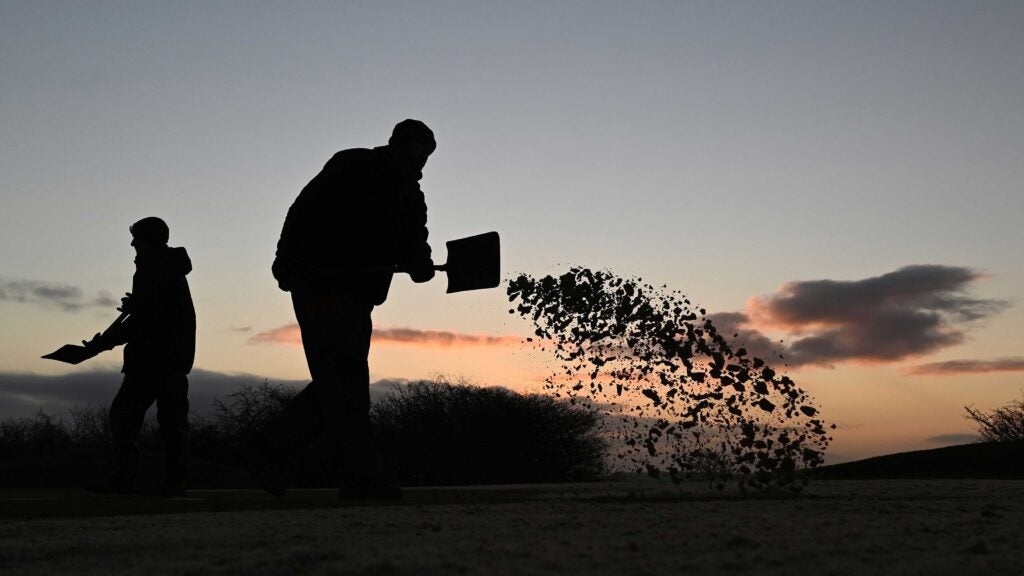Welcome to Super Secrets, a GOLF.com series in which we pick the brains of the game’s leading superintendents. By illuminating how course maintenance crews ply their trades, we’re hopeful we can not only give you a deeper appreciation for the important, innovative work they do but also provide you with maintenance tips that you can apply to your own little patch of paradise. This week, we queried supers about some of the less glamorous parts of the job.
***
Fresh air. Sunshine. Long hours on the links. All things considered, superintendents have sweet gigs, and every golfer should be grateful for the sweat equity dedicated supers invest in caring for our courses. But even dream jobs have downsides! We anonymously polled superintendents around the country to identify the duties they most dread. Here are nine of those unpleasant tasks.
1. Aeration
This “time-consuming, backbreaking job” is also the “most important cultural practice we perform each year,” says a Massachusetts superintendent. Problem is, the proper time to do it is when the grass is growing and the soil is warm, which means during golf season, which, in turn, he says, has a tendency to irritate golfers.
2. Leaf-wrangling
If you think of foliage as an autumnal issue, think again! “We start dealing with leaves in the fall and go right on through till spring,” says a New Jersey superintendent. “That means we spend hours raking them, bagging them, blowing them and mulching them, while taking care not to blow them into the yards of nearby homes.” The next day, they do it all again.
3. Geese and Coot Control
“It’s a huge pain,” says a California superintendent, who has hired both a falconer and drone-operator to help scare away the birds. Might be time to get a well-trained dog.
4. Dealing with Homeowners
They want trees trimmed or removed so they have views of the mountains. They gripe about grass clippings in their pool, or sprinklers spraying water against their fence. “It’s always something,” an Arizona superintendent says. “And they think it’s our job to deal with it all.”
5. Topdressing Greens
Like aeration, topdressing is a crucial but disruptive practice, particularly for public courses, which don’t have the private-club luxury of completing it on Mondays, when the grounds are closed. And so the job, which involves a tow-behind unit similar to a road-salt spreader, tossing sand across the surface of the green, is carried out between groups of golfers. “You can paint a picture pretty quickly of how well this goes over with golfers,” a Massachusetts superintendent says. “And how much we look forward to doing it.”
5. Frost Delays, Heated Conversations
Frost delays are a nuisance. But they’re not as big a headache as golfers complaining about frost delays. “There’s nothing I like less than standing in the pro shop explaining to irritated golfers why we can’t let them on the course,” an Ohio superintendent says. Come to think of it, there is something he likes even less: when golfers ask him to predict when the frost will lift. “My answer is the same every time: if I knew that, I wouldn’t be working here.”
6. Tree Trimming
A tiresome job, especially in winter, a Michigan superintendent says. “You wind up smelling like a chainsaw, and running the wood chipper gets very old, very fast.”
7. Storm Clean-up
When Tropical Storm Hermine hit the Southeast in September 2016, it made a mess of golf courses. One Georgia course spent three weeks cleaning up — clearing debris, re-applying pine straw — only to see another storm, Hurricane Matthew, blow in on Oct. 4 and knock down 10,000 trees. “We knew we’d get it cleaned up, but certainly it was hard to keep motivation,” says the course’s superintendent. “That was obviously an extreme case, but it happens often on smaller scales every day: We strive to get the course perfect every day, only to have to come back the next day and fix everything…trying to achieve perfection again.”
8. Irrigation System Blow Out
Performed in Northern climates with freezing winters, this practice, usually carried out in November, involves hooking up a giant air compressor to every sprinkler head on the course, and then running those sprinklers until they are blowing water for at least 60 seconds. The process is then repeated the next day as water settles in the low spots of the pipes. Overall, the job takes 3 to 4 days, a Massachusetts superintendent says. Late in the year, sprinkler heads can be hard to find because they’re overgrown with grass or covered with leaves. Sometimes, an early storm will bury the heads in snow, making the job nearly impossible. “You also always worry you missed areas,” the super says, “which will result in frozen heads and broken pipes come spring.”
9. Cleaning Bird Droppings off Ball Washers
But worse than that, says an Arizona superintendent, “is listening to member complaints” about those droppings. “We clean it off and at some point, more appears. It’s not exactly something we can stop.”
